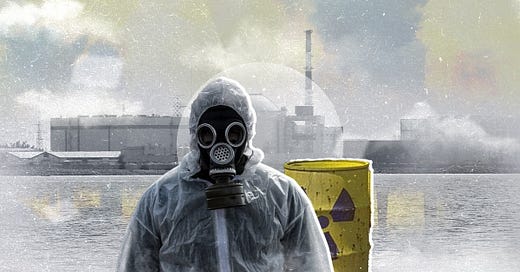The Nuclear Reactor Looming Over the Gulf
“We Bombed Nuclear Sites, Including Bushehr on the Gulf Coast!”
With this statement, an Israeli military spokesperson sparked a political and security firestorm, prompting rapid responses from Iran, Russia, and the International Atomic Energy Agency (IAEA) within hours.
Israel quickly walked the statement back: “It was a mistake” to claim the Bushehr reactor was bombed, said another military spokesperson.
That same spokesperson confirmed that Iran’s Natanz, Isfahan, and Arak nuclear sites were targeted. But few seemed to care much—these sites had already been under attack for days.
So why did Bushehr trigger a storm? The answer lies in a single word: reactor.
Natanz and Isfahan are uranium enrichment facilities, while Arak is a relatively small reactor deep inside Iran, making it less threatening.
“Enrichment facilities do not emit radiation,” says Andrea Stricker, Deputy Director of the Nonproliferation and Biodefense Program at the Foundation for Defense of Democracies, in a statement to Alhurra.
Richard Wakeford, emeritus professor of epidemiology at the University of Manchester, explains that bombing such sites would cause “mainly a chemical issue,” with localized impact.
But bombing a nuclear reactor is a completely different matter. According to Wakeford, it could lead to radioactive leakage either into the atmosphere or directly into the sea.
James Acton, co-director of the Nuclear Policy Program at the Carnegie Endowment for International Peace, issues a stern warning: an attack on Bushehr “could cause a full-scale radiological disaster.”
Andrea Stricker echoes the phrase “radiological disaster,” but doubts Israel would actually strike the reactor. “The Israelis know this,” she says with certainty.
What is the Bushehr Reactor?
Bushehr is Iran’s only nuclear reactor that produces electricity. It lies directly on the Gulf coast and is the country’s first civilian nuclear reactor.
Germany began constructing it in the mid-1970s. After the fall of the Shah and the end of the Iran-Iraq war, Russia took over the project.
The reactor officially went online in 2011 and is operated by Iranian engineers—though Russia plays a significant role: around 600 Russian staff work there, including 250 permanent employees.
The reactor also uses Russian fuel, which Moscow retrieves after use—reducing nuclear proliferation risk.
Immediately after the Israeli “mistaken” claims about targeting Bushehr, Russia’s Foreign Ministry demanded an “immediate” halt to any airstrikes on the plant. President Putin had previously stated that Israel had assured Russia of the safety of its personnel.
Iran, for its part, announced that it had activated air defenses around Bushehr.
The IAEA responded by saying Israel’s statements highlighted the need for “accurate and clear information.”
Gulf Neighbors Watching with Concern
For Arab states across the Gulf, Bushehr has never been just another facility—it’s been a constant threat. Bushehr lies within striking distance of their primary water source: the Gulf.
Qatari Prime Minister Mohammed bin Abdulrahman Al Thani said in March that any attack on Iran’s nuclear facilities would contaminate the entire Gulf’s waters and endanger life in Qatar, the UAE, and Kuwait.
Al Thani declared unequivocally that the Gulf would be left “without water, without fish, without anything… without life.”
These countries rely almost entirely on desalinating Gulf water. In the UAE, for instance, desalinated water accounts for over 80% of drinking needs. In Bahrain, desalination has been the sole water source since 2016.
Qatar also depends entirely on desalinated water.
Saudi Arabia—the Gulf’s largest nation—has relied on desalinated water for 50% of its needs since 2023.
The worst-case scenario these countries fear is contamination of Gulf waters due to a nuclear leak from Bushehr.
While countries like Saudi Arabia and Oman can desalinate from other seas (the Red Sea and Arabian Sea), countries like Qatar, Bahrain, and Kuwait lack that option.
Nidal Hilal, director of the Water Research Center at NYU Abu Dhabi, says that any disaster, leak, or targeted attack that disrupts desalination plants would instantly deprive hundreds of thousands of people of fresh water.
He adds: “Coastal desalination plants are particularly vulnerable to regional risks such as oil spills or potential nuclear contamination.”
The Gulf states are well aware of the risk. In coordination with the IAEA, they have had an emergency response plan in place for years in case of a nuclear incident.
But the danger doesn’t only come from military strikes—it also comes from the ground itself. The Bushehr reactor sits in a seismically active zone.
In 2013, a 6.1-magnitude earthquake struck near the reactor, alarming Gulf states. Iran, meanwhile, insists the reactor is built to withstand quakes up to magnitude 8.
To Tehran, Bushehr is a symbol of the peaceful nature of its nuclear program. Iran is currently constructing two more reactors at the same site, which will triple the plant’s capacity.
Yet none of this reassures Iran’s neighbors, who remain anxious about any incident that could compromise reactor safety.
Today, the reactor continues operating quietly, and the reports of it being targeted now appear to be false. But the entire region watches with bated breath.
Because all it takes is one incident—natural or man-made—for Iran’s scientific “achievement” to turn into a regional catastrophe.





